The North America Nebula (NGC 7000) is a large Emission Nebula, which is around 1600 light-years away from us and located in the constellation Cygnus. The Nebula consists the most of ionized hydrogen (H-alpha), which makes it appear in a red glow. The dark parts on the image are mostly light impervious dust which blocks the light emitted by the ionized hydrogen and the stars behind it. The Nebula has its name from its shape, with a little bit of fantasy, it looks like North America.
Seen from Earth, it has a "visible" size of four times the full Moon. Unfortunately, it is way too dim to bee seen by the eye.
On the left side, there is a small part of the Pelican Nebula (IC 5070) visible, which is also part of this big Emission Nebula complex.
The North America Nebula at a focal length of 420mm.
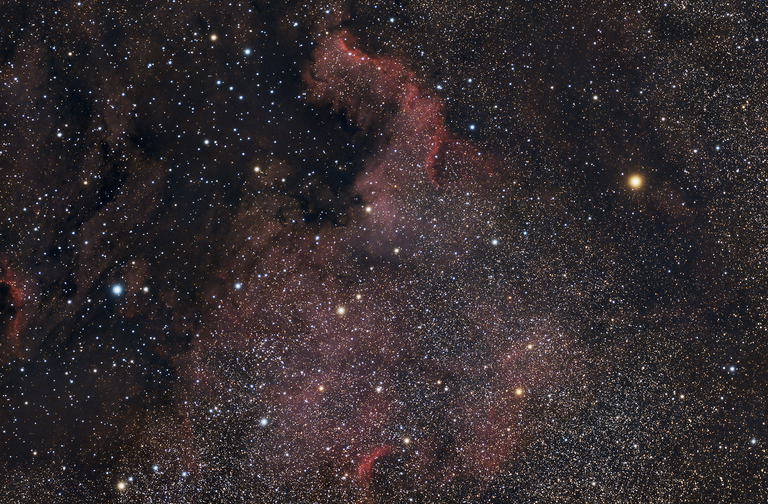
Click on the picture for a larger view ▲
Since the band of the Milky Way crosses the constellation Cygnus, there are very much stars in this region, which can disturb on pictures. Due to the enormous number of stars, the proper Nebula cannot be appropriately perceived. For this reason, I tried to create an image version with fewer stars. If someone should be boring, he can start counting. The program has counted 7295 stars, but the small ones are not taken into account, because they are considered image noise.
My attempt to reduce the stars so that the nebula can be better recognized.
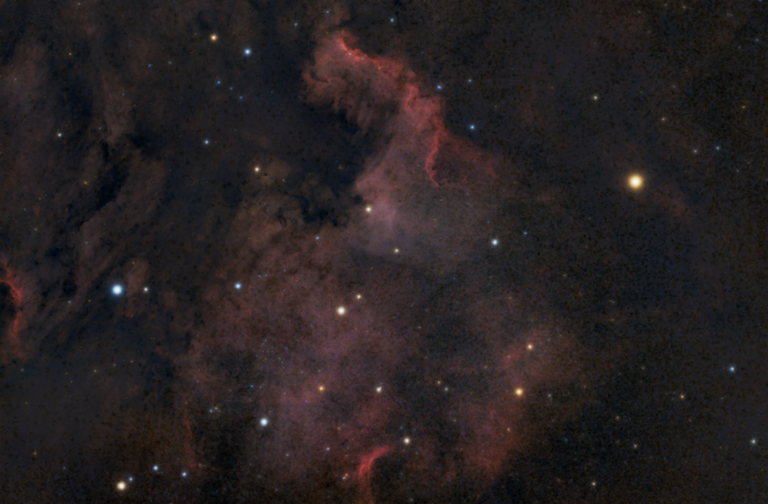
Click on the picture for a larger view ▲
Sadly, there occurred many artifacts on the places where the stars were before. I think that more exposure time would have been good and would have increased the quality of the final image. Once again, the weather didn't give me another chance until now, so that I have to be lucky with this 85 minutes I was able to capture.
Position in the night sky
As mentioned before, the North America Nebula is part of the constellation Cygnus. It is a striking summer constellation on the northern hemisphere and can be easily found by its larger and brighter stars, which build a cross with the very bright star Deneb.
Position of the North America Nebula in the night sky. Screenshot of SkySafari Plus app for iOS.
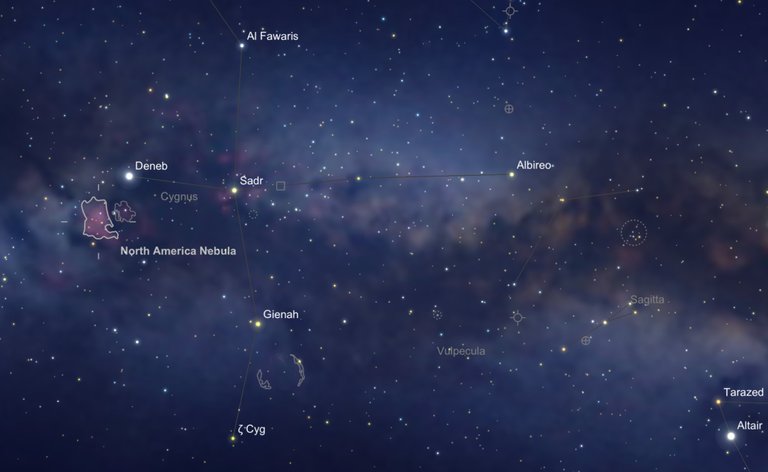
Click on the picture for a larger view ▲
What else is on the image
In the following picture, I have marked some objects. On the left side, there is a small part of the Pelican Nebula (IC 5070), a bit further to the right, between the bright stars, there is the Open Cluster NGC 6997. Furthermore, I have named some of the bigger stars.
Image with names of some objects/stars. Created by hand in Photoshop.
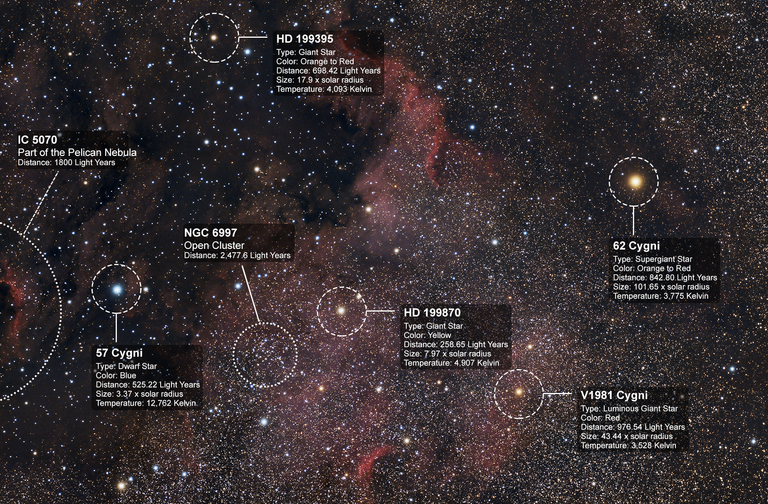
Click on the picture for a larger view ▲
Details of the image
The picture was taken in my Backyard with the following equipment and settings.
| Camera | QHYCCD247C |
| Telescope | TSAPO65Q · 420mm · f6.5 |
| Filter | Astronimik Luminance L2 (48mm / 2") |
| Guide camera | QHY5L-II |
| Guide scope | TSL60D · 240mm · f4.0 |
| Mount | Skywatcher AZ EQ-6 |
| Exposure time | 17 x 300" = 85 minutes |
| ISO | Unity Gain @ -20°C |
Everything is controlled by my Astro-PC via remote desktop and wireless LAN.
Software: Sequence Generator Pro, PixInsight, Photoshop CC
The license of my pictures
All images, otherwise clearly indicated, in this post are my own work.
You can use it for free if you credit them to @astrophoto.kevin.
 Attribution-ShareAlike 4.0 International (CC BY-SA 4.0)
Attribution-ShareAlike 4.0 International (CC BY-SA 4.0)
References
https://www.universeguide.com/star/xicygni
https://www.universeguide.com/star/57cygni
https://www.universeguide.com/star/hip103519
https://www.universeguide.com/star/hip103282
https://in-the-sky.org/data/object.php?id=NGC6997
https://en.wikipedia.org/wiki/Pelican_Nebula
https://en.wikipedia.org/wiki/North_America_Nebula
https://in-the-sky.org/data/catalogue.php?cat=Tycho&const=32&sort=0&view=0
Thank you very much for visiting and reading!
If you have any questions or suggestions, please don’t be afraid to let me know of anything you thought about this post in the comments below!
Yours, @astrophoto.kevin

SteemSTEM is a community project with the goal to promote and support Science, Technology, Engineering and Mathematics on the Steem blockchain. If you wish to support the steemSTEM project you can:
Discord community | Delegate SP to steemstemContribute STEM content using the #steemstem tag | Support steemstem authors | Join our curation trail | Visit our
Thank you for the stunning pictures. The best one, for me was the first, with all the 'disturbing' stars. I also very much appreciated the labels on the last picture. I had noticed the very bright 62 Cygni and was glad to have an identifier.
I looked up 'Cygnus', and see that it means swan. I think it takes a great imagination to see a swan in that constellation, although I've never looked at it through a telescope. You have...what do you think?
I loved your post.
I really appreciate that you like the images. My favorite is also the first one, despite the many "disturbing" stars. It shows this part of the night sky as it is. The mass of stars is quite a sensation in its own.Thank you very much for your kind words @agmoore2
You're right, the constellation Cygnus is also called "Schwan" in German. In fact, it takes a lot of imagination. I don't always recognize similarities with the names. I would rather call it "cross of Deneb" :-D
Since the constellation is quite big, you can only see fractions through a telescope. Looking with the eyes, however, you can see the prominent bright stars.
I've been looking for that swan since yesterday :)) It seems many people are determined to see it. I don't, but still the hunt has let me see some more spectacular photos.
There are some quite good apps for the smartphone. Star Walk (2) should be a very nice one and also free of use with some adds. It allows you to turn on the phone's gyroscope, which helps a lot finding some stuff in the sky.
Sometimes it is very hard to find some constellations, even when they are big and should be conspicuous. There are always some stars, that makes it look different :-)
In the image on this site there are also small and big dipper, which makes it maybe a little bit easier to find it whith drawing imaginary lines between the stars.
http://www.astronomytrek.com/star-constellation-facts-cygnus/
Yes, there are some very spectacular photos out there. These are the reason why I started this astrophotography stuff a few years ago.
This one was the "hobby initiator" and it is still one of the best I ever saw. An exposure time of 212 hours is just crazy. https://volskiy.smugmug.com/Nebulas/i-8dZ6DdL/A
Wow! Thank you. What fantastic pictures. I will have great fun with these. You know, Steemit has a lot of issues, but where else can I find this kind of blog, and this kind of interaction?
Thanks again...I'm a sky tourist now :))
You're welcome :-)
Yes, steem(it) has a lot of problems. But there are also great users and things here. It's up to us to keep/make the chain good and useful :-)
I'm glad to hear I got you interested in the night sky. Enjoy it, there is a lot to "see" above our heads.
Richtig klasse!
Thanks for sharing these information.
Have a nice weekend
Cheers
Chapper
Dir auch ein schönes Wochenende :-)
CheersVielen Dank @chappertron :-) Auch für die super Erwähnung bei @chappzilla :-)
Beautiful! Really! I am starting to get interested in astrophotography (mainly thanks to one of a friend of my son whose family is heavily involved (and showed me their installation)).
I am wondering how long it takes you to take the picture and to work on it on the software size. Also, how big are the raw data files? My friend is spending hours both on taking pictures and working on them.
It's actually a great hobby if you like cold nights, a lot of tiredness and frustration :-D
Astrophotography and telescope installations can be very impressive. I never thought myself to get one day to this amount of equipment as I started with a DSLR, zoom lens and a small star tracker.Thank you very much for your kind words @lemouth :-)
I'm actually never done taking the raw data for an image. If I'm able to do astrophotography and there is no other object I've chosen, I will collect photons for an already "finished" object again. Fortunately, the objects don't change that quickly and will look the same also some years later.
Especially for this image of North America Nebula, I captured images in two nights. In the first, I was not able to get one useful image. Either a neighbor turned on the light, or clouds came or the focus shifted. In the second night, I have got a total of 21 images with 5 minutes each. Then the clouds came in and stood until now at night. At the moment I'll try a lot to get some of the imaging procedure more automated and stable. Refocusing each hour is wasting a lot of time, which could be used for imaging. A new computer for controlling all is nearly finished, I just need to build some parts to supply power to all components.
My longest project was the Orion Nebula which took me around one week of sleepless nights. There went so many things wrong :-)
For the software side, It is going faster as more images are captured. Stacking itself needs more time, but working out the details goes a lot faster due to the better signal to noise ratio. Also for this image here, it took around 6 hours with a lot of trial and error. But somehow, an image is never finished. Either new RAWs are added, or after some time you are still not satisfied with something in it.
The RAW files of my camera have 46.2MB, which is OK for 24MP I think. My Nikon D7100 has around 27MB for a compressed RAW. It will take some time to fill a 1TB drive with RAWs that are good enough to be used for further editing.
Thanks for those details. Indeed, long nights are necessary (when I was at my friends place, we barely see a single star (thanks to the clouds). On the next day, the night was lovely (but I was busy elsewhere). In short, I didn't have the chance to experience it... yet. But this is on the to-do list for the next vacation, if weather permits. I have the chance to leave in a small village a bit far from everything. Even if Paris is next door (70 km from here), we are quite ok regarding light pollution.
You're welcome :-)
Soon the nights will be longer in autumn. Unfortunately, the air will be much more humid than, so that there will be more fog and clouds. I hope for a dry autumn anyway.
I'm pretty sure you will have the chance to experience it :-)
A small village is a good prerequisite. The 70km to Paris should also be far enough away. Sadly, light pollution has become a major problem of our time, which is not so really noticed. I'm very happy to live in a small town with still low light pollution but due to the cheap, energy-saving and powerful LED lights, it's getting more and more worse, even here.
In the village where I live, they move to a technology beyond LED that is even better concerning light pollution. I forgot the name of the technology, but light is really concentrated close to the source (and it consumes less energy in total)..
Anyways, I will see when my next experience will be ;)
That sounds really interesting. It would be also nice to see something like that here. In Germany, we are unfortunately quite far behind in technological terms. This is how it seems to me :-D
I hope you will have your experience soon :-)
I will have to wait at least 3 weeks as I will go to Germany tomorrow (2 weeks in Mainz) and then Italy (3 days in Trento). Work has restarted, and so have the trips :)
The images are stunning! Still, I have no inclination to start counting the stars on them :D I enjoyed learning about Cygnus and the North America nebula. Also, I agree with you. To say the nebula's shape resembles that of North America is a bit of a stretch ! :D
Beautiful work here @astrophoto.kevin. Thank you for sharing it with us!
Thank you very much Abigail 😊
The names usually require a lot of imagination to recognize a similarity. 😁
I’m glad I could show you something about Cygnus and the North American Nebula.
Damn, nobody is counting the stars for me. 😂
😂 😂 😂
Good blog bro keep sharing..
Thank you :-)
Deine Sterenenbilder sind immer wieder sehr schön anzusehen. Wie legst du die einzelnen Fotos übereinander? Wie verhinderst du dass du "Sternenzieher" hast bei so langen Belichtungszeiten, die Erde dreht sich ja in der Zwischenzeit.
Vielen Dank Florian :-)
Die einzelnen Bilder lege ich mit PixInsight übereinander. Als Freeware gäbe es z.B. DeepSkyStacker, das Prinzip ist damit das gleiche wie bei PixInsight. Umso mehr einzelne Bilder verwendet werden umso weniger wird das Rauschen und die feinen Details werden sichtbar.
Das müsste der Teil mit dem eigentlichen stacken sein. https://steemit.com/de-stem/@astrophoto.kevin/einfuehrung-in-die-bildverarbeitung-von-astrofotos-mit-pixinsight-teil-4
Das ausgleichen der Erdrotation macht die Montierung. Diese wird auf die Erdachse ausgerichtet und dreht sich mit. Da dies allerdings auch Fehler aufweist (Getriebe, Ausrichtung, ...), nimmt zusätzlich ein kleineres Teleskop mit Kamera immer einen Stern auf. Die Bilder werden dann mit einem Programm analysiert und die Nachführung dann bei einer Abweichung korrigiert. So werden dann die meisten kleineren Fehler korrigiert.
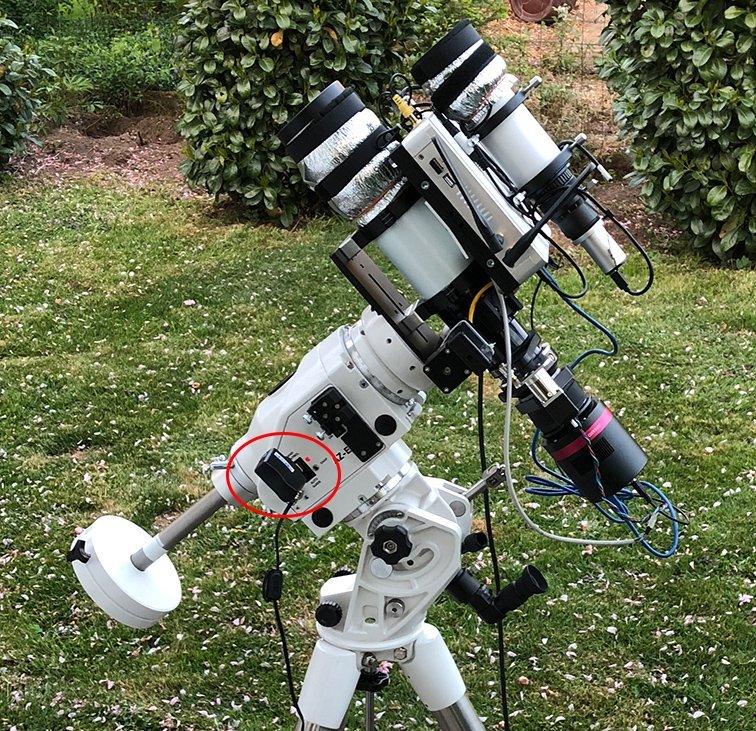
Oben das kleine Teleskop für die Korrektur und unten das Teleskop für die Aufnahmen.
This is some serious, impressive kit @astrophoto.kevin !
Thanks Abigail 😊
I already plan to get it a little bit more serious with a larger aperture. I hope this should help me to catch more photons in the few clear nights we have.
I look forward to seeing those super photos then! :D
PS: I am so sorry. I just realized now that I'd forgotten to upvote your post before!
Unfortunately, I will still need some time. My piggy bank is just filling slowly and, sadly, those "fast" scopes are a little overpriced :-D
No problem, I'm also happy to answer comments without the need of an upvote ;-)
Klingt ganz schön aufwändig. Aber sehr cool.
Posted using Partiko Android
Das schöne ist, dass wenn es läuft, die Nachführung automatisch korrigiert wird. Somit fällt schon mal ein ganzes Stück "Arbeit" weg.
I Love your Photos😘
Thank you for this fantastic pictures☺👍
Posted using Partiko Android
Das kann ich nur erwidern, wenn ich eure Reiseberichte und die Bilder betrachte 😊Thank you so much for your kind words @diereiseritter 😊
These photos are amazing. I always like looking up at space and dreaming. Much better with a telescope and the Internet.
I really appreciate you enjoying them :-)Thank you very much @kpopprincess :-)
Good blog bro keep sharing..